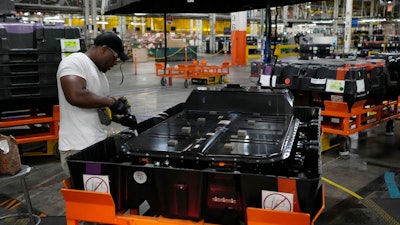
WASHINGTON (AP) — The nation’s employers slowed their hiring in October, adding a modest but still decent 150,000 jobs, a sign that the labor market may be cooling but remains resilient despite high interest rates that have made borrowing much costlier for companies and consumers.
Last month’s job growth, though down sharply from a robust 297,000 gain in September, was solid enough to suggest that many companies still want to hire and that the economy remains sturdy.
And job growth would have been higher in October if not for the now-settled United Auto Workers’ strikes against Detroit’s automakers. The strikes ended this week with tentative settlements in which the companies granted significantly better pay and benefits to the union’s workers.
The unemployment rate rose from 3.8% to 3.9% in October. In another sign of a possible softening in the labor market, the Labor Department revised down its estimate of job growth in August and September by a combined 101,000.
The UAW strikes resulted in an overall loss of 35,000 factory jobs in October. Among the sectors that posted solid job gains last month were healthcare, which added 58,000, government agencies 51,000 and construction companies 23,000.
By contrast, the vast leisure and hospitality sector, which includes bars, restaurants and hotels, reported only modest job growth. So did professional and business services, a category that includes such high-paying occupations as accounting, engineering and architecture.
Wage pressures, which have been gradually slowing, eased further in October. Average hourly pay rose 0.2% from September and 4.1% from 12 months earlier. The year-over-year wage increase was the lowest since June 2021; the month-over-month rise was the smallest since February 2022.
Friday’s jobs report from the government comes as the Federal Reserve is assessing incoming economic data to determine whether to leave its key interest rate unchanged, as it did this week, or to raise it again in its drive to curb inflation. Last month's slowdown in pay increases, along with the lower job gain, could help convince the Fed that inflation pressures will continue to cool and that further interest rate hikes may not be needed.
On Wall Street, traders appeared to signal their growing belief in that scenario. Bond yields fell and stock prices rose sharply after the jobs report was released, indicating optimism that the Fed will decide it won't need to impose additional rate hikes.
The Fed has raised its benchmark interest rate 11 times since March 2022 to try to slow the economy and tame inflation, which hit a four-decade high last year but has slowed sharply since then. In September, consumer prices rose 3.7% from a year earlier, down drastically from a year-over-year peak of 9.1% in June 2022 but still well above the Fed’s 2% target level.
The U.S. job market has remained on firm footing despite those rate hikes and has helped fuel consumer spending, the primary driver of the economy. Employers have now added a healthy 204,000 jobs a month over the past three months.
The combination of a solid economy and decelerating inflation has raised hopes that the Fed can nail a so-called soft landing — raising interest rates just enough to tame inflation without tipping the economy into recession.
“This is still a good labor market,’’ said Nick Bunker, head of economic research at the Indeed Hiring Lab. “There’s no recession right now that you can see in the labor market data.’’ Bunker added that the October jobs numbers are “mostly consistent with the soft landing story.’’
For the Fed, one unwelcome note in Friday's report is that the number of people in the labor force – those who either have a job or are looking for one — fell by 201,000 in October. It was the first such drop since April. Over the past year, more than 3 million people have entered the workforce, making it easier for companies to fill job openings. This has reduced pressure on employers to jack up pay and pass on their higher labor costs to their customers through higher prices. But the trend was broken last month.
The Fed’s policymakers are trying to calibrate their key rate to simultaneously cool inflation, support job growth and ward off a recession. Despite long-standing predictions that the Fed’s ever-higher rates would trigger a recession, the U.S. economy grew at a 4.9% annual pace from July through September, the fastest quarterly expansion in more than two years.
And many companies are still looking to hire. On Wednesday, the Labor Department reported that employers posted 9.6 million job openings in September, up slightly from August. Opening are down substantially from the record 12 million recorded in March 2022 but are still high by historical standards: Before 2021 and the economy’s powerful recovery from the COVID-19 recession, monthly job openings had never topped 8 million. There are now 1.4 jobs available, on average, for every unemployed American.






















